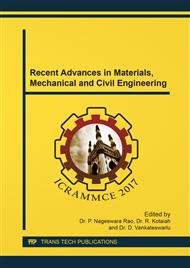p.366
p.372
p.378
p.384
p.391
p.397
p.403
p.409
p.414
Design Optimization of Squeeze Mode Magnetorheological Damper
Abstract:
Mostly, magnetorheological damper research is going on flow mode and shear mode type of damper. Less work is carried out by researcher on squeeze mode type of damper. This will give higher force as compare to flow mode and shear mode type of MRF damper at low excitation. So, this kind of damper can be used as vibration isolation for high impact loading at low amplitude application like engine mount. Aim of this paper is optimized design of Squeeze mode damper for low amplitude application by using design of experiment tool. For design of squeeze mode type of MR damper magnetic field distribution is very important study to improve damping performance. Various parameters like length of coil, diameter of squeeze plate, current passing through coil, number of turns, area of coil and MR fluid gap are considered during optimization and optimization is done by using FEMM software It shows that length of coil, Number of turn and area of coil increases damping performance improves. Other design parameters are check out with mathematical model of MR damper with theoretical calculation like effect of frequency of excitation, diameter of squeeze plate, thick ness of squeeze plate and amplitude of excitation.
Info:
Periodical:
Pages:
391-396
Citation:
Online since:
February 2018
Authors:
Keywords:
Price:
Сopyright:
© 2018 Trans Tech Publications Ltd. All Rights Reserved
Share:
Citation:


